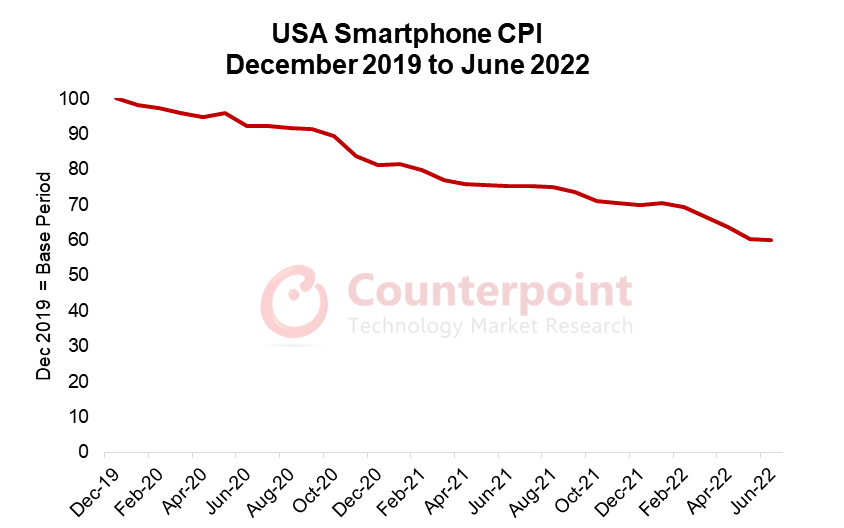Trends
20% YoY decline in US smartphone CPI
The US Consumer Price Index (CPI) measures the average change over time of a basket of goods and services. It is one of the primary measures of inflation. The recent June report notes that the CPI for all urban consumers rose 9.1% over the last 12 months not seasonally adjusted.
However, during the same period, smartphone CPI declined 20% YoY. In fact, taking December 2019 as the base period, we have seen smartphone pricing decline almost every month. What does this all mean?

Looking at these numbers don’t tell the full story. While the CPI does provide a good indication of inflation, when looking at the goods and services measured, it ignores the role of promotions and discounts in reducing prices. Though the smartphone market has been fiercely competitive, full retail prices for smartphones have increased over the last several years if we ignore promotions and discounts.
5G rollouts heighten carrier competition, sweeten deals
- Carrier promotions have increased over the years as they try to grab subscribers from each other and get more subscribers on their 5G networks.
- AT&T has pledged a promotional strategy that gives both new and old subscribers the same deals, eliminating the surprise price increases that consumers often face after promotional pricing runs out.
- Verizon has been very aggressive with its trade-in offers, even allowing for broken devices to be traded in for full value at times.
- T-Mobile has been touting its Great Free 5G Phone Upgrade program and other promotions for well over a year. We have not seen promotions cool in 2022 yet. Instead, they are better than in 2021 in many cases.
Improvements in smartphone design, components raise prices
- Since the introduction of first 5G smartphones in 2019, we have seen full retail prices for devices increasing due to the added cost of 5G modules and increases in other specs to optimize 5G technology.
- In addition, foldables entered the market at very high retail prices and have continued to remain a premium product.
- Lastly, due to the component shortages of 2021, there was a lack of LTE chipsets, which drove up costs for manufacturers as they had to pay for higher-priced 5G SoCs.
- According to Counterpoint’s USA Channel Share Tracker, wholesale prices increased by about 20% YoY in Q2 2022.
Will we see prices increase in future?
- Japan’s yen recently depreciated an almost unprecedented 20% against the US dollar, making Apple and even the carrier Rakuten raise iPhone and other Apple product prices by 20%-40%, stirring up concerns of price hikes in other countries.
- In the case of Japan, many were buying these iPhones and trying to resell or ship them to other markets. The price increase took this into account.
- In general, Apple pricing and volumes are locked in by carriers and rarely change in most countries. This sort of price increase in the middle of a sales cycle will likely be more rare in other economies and highly dependent on further unprecedented currency depreciation.
- Supply chain and logistics costs may increase smartphone prices in the future. However, so far, these have not been passed on to the consumer in the US. Carriers are absorbing these costs by increasing services and other fees.
CT Bureau














You must be logged in to post a comment Login